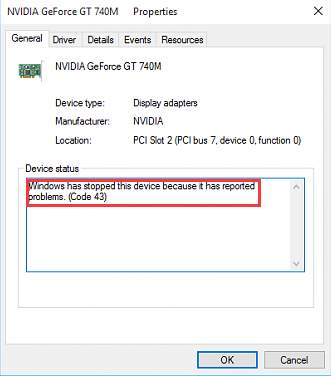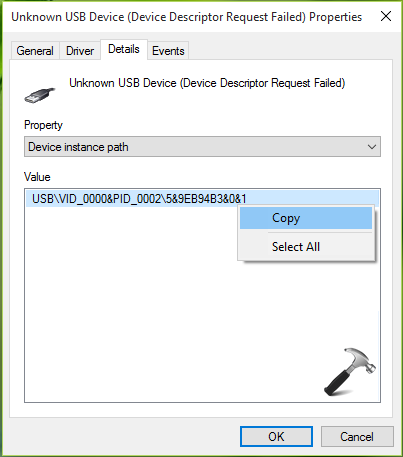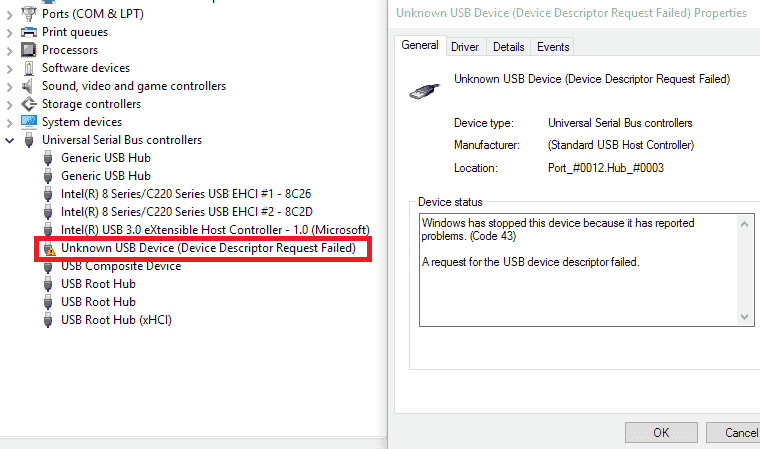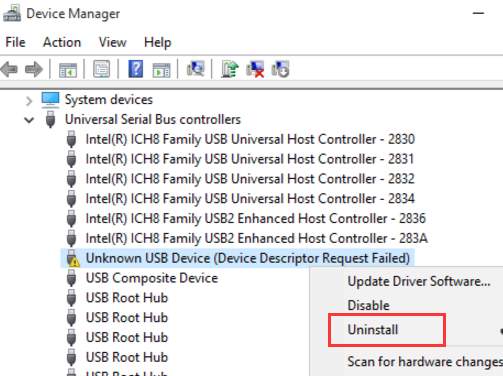Note: On rare occasions Windows may not install Device Drivers and you may end up with no USB Ports working. Right-click on Start button and then click on Device Manager. On the Device Manager screen, expand the entry for Universal Serial Bus Controllers. Windows 10: Unknown USB Device (Device Descriptor Request Failed). Hopefully it's more of a Windows 10 driver thing than USB 3.0. Ev1lchris Senior Member. Connect the USB device to your PC, download and launch EaseUS disk Data Recovery, select the.
-->This article helps to fix an issue in which Windows 10 doesn't install specific drivers for USB audio devices on the first connection.
It is located under Universal Serial Bus Controllers. Expand it and right-click on Unknown USB Device (Device Descriptor Failure). Click on Uninstall device. Now, unplug the USB device from your computer, if it wasn’t already unplugged, and plug it back in the USB slot. Scan for hardware changes. This is the most recent driver for the EV2300:EV2300aDeviceDriverInstallerMultilanguage0.6 (3) (1).zip. I would suggest using an EV2400. It uses the HID class to communicate over USB so drivers are already built into windows. Best Regards, Ben Lough.
Original product version: Windows 10, version 1703
Original KB number: 4021854
Symptom
When you connect a USB audio device to a Windows 10 Version 1703-based computer the first time, the operating system detects the device but loads the standard USB audio 2.0 driver (usbaudio2.sys) instead of the specific device driver.
Cause
This issue occurs because the USB audio 2.0 driver (usbaudio2.sys) isn't classified as a generic driver in Windows 10 Version 1703. Therefore, the system assumes that a compatible, nongeneric driver is installed for the device even though the driver is generic.
This issue also causes Windows 10 Version 1703 to postpone the search for other compatible drivers through Windows Update that typically occurs immediately after you install a new device.
Download Device Driver Windows 10
Resolution
To fix this issue, use one of the following methods.
Method 1
To resolve this issue, install update 4022716.


Method 2
If the device-specific driver is distributed through Windows Update, you can manually update the driver by using Device Manager. For more information about how to do this, see update drivers in Windows 10.
Method 3
If the device is not yet connected, first install the device-specific driver, such as by using the appropriate installer. After the device-specific driver is installed, Windows 10 will select that driver instead of the standard USB audio 2.0 driver when you first connect the device.
Note
See the device manufacturer's user guide for specific instructions about how to install the driver.

Method 4
If the driver isn't distributed through Windows Update, you can manually reinstall the driver. To do this, follow these steps:
- Install the device-specific driver (see Method 2).
- Open Device Manager.
- Right-click (or tap and hold) the name of the device, and then select Uninstall.
- Restart the computer.
When it restarts, Windows will try to reinstall the device by using the device-specific driver.
In case you are experiencing USB Device Not Recognized Error, whenever you plug in a USB mouse or Keyboard, you can make use of the following methods to Fix USB Device Not Recognized error in Windows 10.
USB Device Not Recognized Error in Windows 10
USB Device not recognized error in Windows 10 is not only noticed while connecting new USB devices, it is also noticed in case of USB devices like your Mouse or Keyboard that are already plugged into the computer.
Irrespective of the case, you should be able to fix USB Device not recognized error in Windows 10 by using one of the following methods.
- Disconnect USB Devices and Restart
- Unplug Computer From Power Cable
- Update Device Drivers
- Check For Updates
- Disable USB Selective Suspend Setting
- Change Power Management Settings
- Uninstall Faulty Device Drivers
Make sure that you do not skip the first and the second methods as listed below.
1. Disconnect USB Devices and Restart
Disconnect all USB devices and then Restart your computer.
Once the computer restarts, plug back the USB device into the same USB port which was not recognizing it. If this does not work, try connecting the device to other USB ports on your computer.
2. Unplug Computer From Power Source
The reason for USB device not recognized error in Windows 10 could be due to your computer going through minor software glitches.
To clear this, simply Power OFF your computer and also unplug it from the power source. Wait for 5 minutes and Restart your computer.
Sometimes, this simple step can fix USB device not recognized error on your computer.
3. Update Device Drivers
Your Windows computer should automatically update the firmware for all device drivers. However, this may not always happen, resulting in device drivers becoming outdated.
1. Right-Click on the Start button and click on Device Manager option.

2. On the device Manager Screen, expand the entry for Universal Serial Bus Controllers.
3. In the expanded Universal Serial Bus Controllers, right-click on the Unknown device and click on Properties.
4. On the next screen, go to Driver tab and click on Update Driver button.

5. On the next screen, click on Search Automatically for updated driver software option.
After installing updated driver, see if your computer is able to recognize the USB device.
4. Check For Updates
See if an Update is available for your computer. If an update is available, Windows will also install the latest available drivers for your computer.
1. Click on the Start button > Settings Icon > Updates & Security.
2. On the Update and Security screen, click on Windows Update in the side menu and click on Check For Updates button.
3. Allow Windows to check for available updates and install them onto your computer
In case updates are available, the latest available device drivers will also be installed on your computer.
Unknown Usb Device Driver Windows 10 Download
5. Disable USB Selective Suspend Setting
By default, Windows computer is set to conserve power by suspending power supply to external USB devices, whenever they are inactive.
However, this power saving setting can sometimes cause problems like Error Code 43 and USB Device Not Recognized Error in Windows 10.
1. Open Control Panel on your computer.
2. On the Control Panel Screen, make sure that you are in “Category” view and click on System and Security.
3. On the System and Security Screen, click on Power Options.
4. On Power Options screen, click on Change Plan Settings link located next to the current Power Plan.
5. Next, click on Change Advanced Power Settings link.
6. On the next screen, click on USB Settings > USB selective suspend setting and select disabled option for “Plugged In” and also for “On Battery” in case you are using a Laptop.
7. Click on OK to save above settings.
6. Change Power Management Setting For USB Root Hub
1. Right-Click on Start button and then click on Device Manager option.
2. On the device Manager Screen, expand the entry for Universal Serial Bus Controllers.
3. Right-click on USB Root Hub and click on Properties.
4. On the Properties screen, click on Power Management tab and uncheck the option for “Allow the computer to turn off this device to save power” and click on OK.
In case you have more USB Root Hubs, you will need to repeat the above steps for them as well.
Note: You can recheck “Allow the computer to turn off this device to save power” option, in case this step has not helped in fixing USB device not recognized error on your computer.
7. Uninstall Faulty Device Drivers
The problem of USB device not recognized error in Windows 10 could be due to faulty, corrupted or missing device drivers.
This can be fixed by uninstalling faulty device drivers and allowing Windows to automatically reinstall them back on your computer.
Note: On rare occasions Windows may not install Device Drivers and you may end up with no USB Ports working.
1. Right-click on Start button and then click on Device Manager.
2. On the Device Manager screen, expand the entry for Universal Serial Bus Controllers.
3. In the expanded Universal Serial Bus Controllers, right-click on the faulty device and then click on the Properties option.
4. On the next screen, click on the Driver tab and then click on the Uninstall button.
5. On the pop-up, click on OK to confirm that you do want to Uninstall the driver.
6. Repeat the above steps for other affected devices
7. After all the affected devices are uninstalled, Restart your computer.
Once your computer restarts, Windows should automatically load the right drivers as required for your computer.
